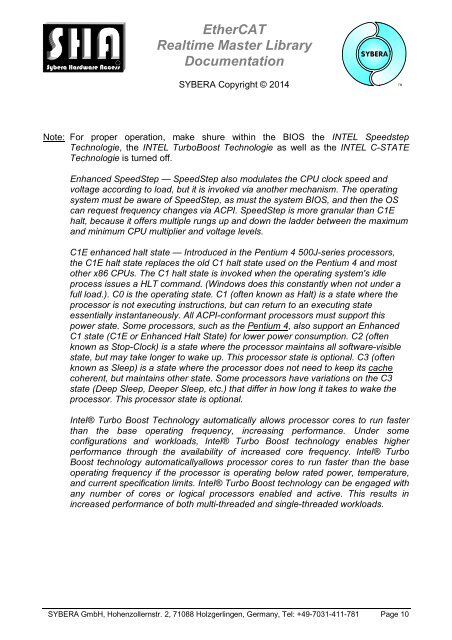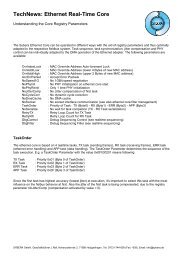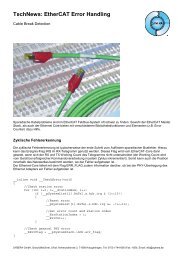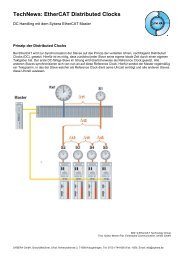manual_ect_clu_e
The EtherCAT realtime library system of SYBERA enables a custom ethernet adapter under Windows as an EtherCAT Master
The EtherCAT realtime library system of SYBERA enables a custom ethernet adapter under Windows as an EtherCAT Master
You also want an ePaper? Increase the reach of your titles
YUMPU automatically turns print PDFs into web optimized ePapers that Google loves.
EtherCAT<br />
Realtime Master Library<br />
Documentation<br />
SYBERA Copyright © 2014<br />
Note: For proper operation, make shure within the BIOS the INTEL Speedstep<br />
Technologie, the INTEL TurboBoost Technologie as well as the INTEL C-STATE<br />
Technologie is turned off.<br />
Enhanced SpeedStep — SpeedStep also modulates the CPU clock speed and<br />
voltage according to load, but it is invoked via another mechanism. The operating<br />
system must be aware of SpeedStep, as must the system BIOS, and then the OS<br />
can request frequency changes via ACPI. SpeedStep is more granular than C1E<br />
halt, because it offers multiple rungs up and down the ladder between the maximum<br />
and minimum CPU multiplier and voltage levels.<br />
C1E enhanced halt state — Introduced in the Pentium 4 500J-series processors,<br />
the C1E halt state replaces the old C1 halt state used on the Pentium 4 and most<br />
other x86 CPUs. The C1 halt state is invoked when the operating system's idle<br />
process issues a HLT command. (Windows does this constantly when not under a<br />
full load.). C0 is the operating state. C1 (often known as Halt) is a state where the<br />
processor is not executing instructions, but can return to an executing state<br />
essentially instantaneously. All ACPI-conformant processors must support this<br />
power state. Some processors, such as the Pentium 4, also support an Enhanced<br />
C1 state (C1E or Enhanced Halt State) for lower power consumption. C2 (often<br />
known as Stop-Clock) is a state where the processor maintains all software-visible<br />
state, but may take longer to wake up. This processor state is optional. C3 (often<br />
known as Sleep) is a state where the processor does not need to keep its cache<br />
coherent, but maintains other state. Some processors have variations on the C3<br />
state (Deep Sleep, Deeper Sleep, etc.) that differ in how long it takes to wake the<br />
processor. This processor state is optional.<br />
Intel® Turbo Boost Technology automatically allows processor cores to run faster<br />
than the base operating frequency, increasing performance. Under some<br />
configurations and workloads, Intel® Turbo Boost technology enables higher<br />
performance through the availability of increased core frequency. Intel® Turbo<br />
Boost technology automaticallyallows processor cores to run faster than the base<br />
operating frequency if the processor is operating below rated power, temperature,<br />
and current specification limits. Intel® Turbo Boost technology can be engaged with<br />
any number of cores or logical processors enabled and active. This results in<br />
increased performance of both multi-threaded and single-threaded workloads.<br />
SYBERA GmbH, Hohenzollernstr. 2, 71088 Holzgerlingen, Germany, Tel: +49-7031-411-781 Page 10







